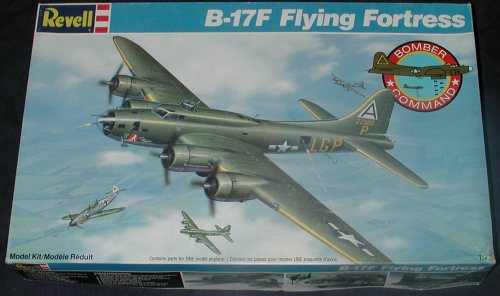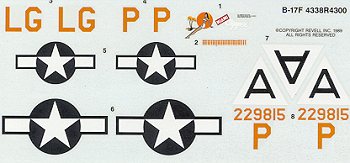
| KIT: | Revell 1/72 B-17F Flying Fortress |
| KIT #: | 4338 |
| PRICE: | $ Currently (2004) out of production |
| DECALS: | One option |
| REVIEWER: | Scott Van Aken |
| NOTES: |

| HISTORY |
Modified from the experiences of the B-17E, the F model was the one that first really took the US daylight bombing offensive to the Third Reich. The British though the Americans mad to attempt to fly unescorted planes over enemy territory during broad daylight. They'd tried it early in the war and their formations were decimated. The American command thought that their heavily armed B-17s and B-24s, if flown in large numbers and keeping formation with lots of covering fire, would be able to withstand the onslaught of the Jagdwaffe. In a nutshell, they were wrong and bomber losses were incredible until the USAAF finally realized that it had a competent escort fighter in the P-51 to be able to provide the sort of long range escort that was needed. It was the Mustang and not the B-17 that enabled the USAAF to successfully carry out its daylight bombing campaign. By mid 1944, the B-17F was being supplanted by the even more capable B-17G, though many Fs continued on until the end of the war in other missions.
| THE KIT |
 Though
dated 1989, the Revell 1/72 B-17F has been around for a heck of a lot
longer than that! I can remember building the 1/48 kit back in the late
1970s and I'm sure the F was being marketed as the Memphis Belle well
before that. This one isn't the Memphis Belle version, but I'm sure the
plastic is the same. Typical of the aircraft of an age gone by, the model
is pretty minimalist. There is but a floor and two seats for the cockpit.
The control surfaces are all separate so they can be posed, and this
includes the flaps. You can retract or extend the landing gear, assuming
you haven't applied too much glue to the pivot housing. The turrets move in
the horizontal plane and that includes the ball turret. There is a shallow
bomb bay with bomb representations and the bomb bay doors are able to be
opened or closed. In
Though
dated 1989, the Revell 1/72 B-17F has been around for a heck of a lot
longer than that! I can remember building the 1/48 kit back in the late
1970s and I'm sure the F was being marketed as the Memphis Belle well
before that. This one isn't the Memphis Belle version, but I'm sure the
plastic is the same. Typical of the aircraft of an age gone by, the model
is pretty minimalist. There is but a floor and two seats for the cockpit.
The control surfaces are all separate so they can be posed, and this
includes the flaps. You can retract or extend the landing gear, assuming
you haven't applied too much glue to the pivot housing. The turrets move in
the horizontal plane and that includes the ball turret. There is a shallow
bomb bay with bomb representations and the bomb bay doors are able to be
opened or closed. In  short, a
typical 60s kit. Overall detail is a bit soft and much consists of a lot of
nice rivets. There are some sink areas and a bit of flash, but considering
how old the kit is, it isn't that bad.
short, a
typical 60s kit. Overall detail is a bit soft and much consists of a lot of
nice rivets. There are some sink areas and a bit of flash, but considering
how old the kit is, it isn't that bad.
Instructions are quite good and up to the standards of 1989, providing 21 construction steps and color information when needed. The color chart provides only generic names. Decals are very glossy and the yellow looks more like orange to me. Markings are for the box art plane, 'Miami Clipper'. I'm not sure how well the decals will work, but there have been a number of 1/72 B-17F decal sheets released in the last few months so one of those would probably be your best bet.
| CONCLUSIONS |
Most of you will bypass this one for the Hasegawa or Academy versions, which are both newer than this one. However, if you have one laying about the house, it wouldn't be a bad one to build for the pleasure of it. I'm sure that most of us who have been around for any real length of time have built this one and it is like an old friend.
Review kit courtesy of your editor.
If you would like your product reviewed fairly and quickly by a site that has over 250,000 visitors a month, please contact me or see other details in the Note to Contributors.